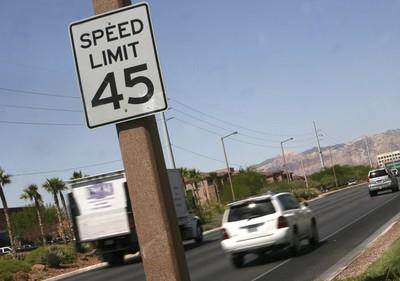Driving Over And Under

This week, readers want to know if a speed limit is a suggestion or a command, and why there’s a bunch of road-fixin’ going on down Searchlight way.
And the Road Warrior finds out when you need to replace a raggedy old thingamajig with a shiny new doohickey under the hood.
Kathleen Beatty asks: In a posted 45 mph zone, what does that mean? One must drive 45 mph? Or does it mean one is limited to 45 mph?
It’s the latter, not the former. “That just means you can’t exceed 45 mph” or whatever the sign says, said Trooper Kevin Honea of the Nevada Highway Patrol, suggesting that people should “drive at a speed you’re comfortable with, where you’re in control of your vehicle.”
According to the Nevada Department of Motor Vehicles, drivers should aim for a “reasonable or proper” speed that uses the posted limit as the suggested top speed in normal, dry driving conditions.
Drivers should also consider the amount and type of traffic; weather conditions; visibility; whether a road is wet or slick; and if a road is narrow, curvy or hilly before setting an actual driving speed using the driver’s best judgment.
“It also means that you are never to drive at a speed that endangers you or anyone else,” the DMV says in its Driver’s Handbook. “Depending upon conditions, the safe speed may be considerably less than the posted speed limits.”
There is such a thing as driving too slowly. The DMV says slowpokes can be unsafe by causing traffic to stack up and prompting other drivers to become impatient and attempt unsafe passes. On multiple-lane roads, slower drivers should stick to the far right lane, and allow faster traffic to pass in the far left lane. Again, use common sense to decide what’s too fast or too slow.
“I tell everybody, when it’s way, way, way below the posted speed limit where you’re causing a safety hazard for motorists,” then you’re driving too slow, Honea said.
And yes, under state law you can be ticketed for driving too slowly “as to impede the normal and reasonable movement of traffic except when reduced speed is necessary for safe operation or in compliance with the law,” according to the state’s law book, known as the Nevada Revised Statues, in Section 484.371.
Jeff asks: What’s going on in Searchlight? They seem to be doing a lot of construction out there.
They sure are. “They” would be the good folks at the Nevada Department of Transportation, who are widening U.S. Highway 95 from 2 1/2 miles south of Searchlight to the city’s northern border, a distance of less than four miles, according to Bob McKenzie, a spokesman for the highway department.
The $11.5 million project started in January and is scheduled to finish sometime in November, McKenzie said. When finished, the two-lane road will be five lanes, broken down into two traffic lanes in each direction, along with a center turn lane. Sidewalks, curbs, gutters and drainage systems are also being upgraded along with the road.
The widening is the second of three phases upgrading U.S. 95 south of Las Vegas. The first phase widened U.S. 95 from the U.S. Highway 93/Railroad Pass junction southward to Searchlight. A final phase, which is now awaiting funding, would add lanes to U.S. 95 from Searchlight southward to state Route 163.
The improvements were sought as U.S. 95 gained more than 2,000 trucks per day after U.S. 93 at Hoover Dam was closed to truck traffic in the wake of the Sept. 11, 2001, East Coast terrorist attacks.
And engineers also wanted to address safety concerns on U.S. 95, where drivers would sometimes attempt to pass traffic on or near blind curves.
Hit ‘n Run: Know when you’re supposed to take care of stuff under the hood? Neither do I. But one slow day of Web-surfing brought me to the Utah Department of Environmental Quality Web site, which actually lists what needs to be done — and when — at www.cleanair.utah.gov/summer_driving.htm.
Among the tips, it suggests changing transmission fluid and filters every 15,000 miles in busy driving conditions; getting oil changes every three months or 3,000 miles in severe driving conditions, but only every six months or 6,000 miles if you have an easy drive; replacing serpentine belts every two years of 30,000 miles; timing belts every 60,000 miles; having brake linings inspected once a year or every 12,000 miles; replacing power steering fluid every 24,000 miles under regular driving conditions or 12,000 miles if you hit a lot of stop-and-go traffic; and getting new spark plugs every 50,000 miles.
Now you know. So do I.
If you have a question, tip or tirade, call the Road Warrior at 387-2904, or e-mail him at roadwarrior@reviewjournal.com or OSofradzija@reviewjournal.com. Please include your phone number.